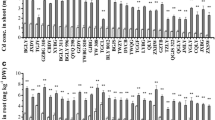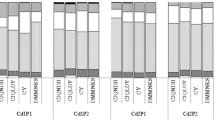Abstract
Selection of a phytoextraction plant with high Cd accumulation potential based on compatibility with mechanized cultivation practice and local environmental conditions may provide more benefits than selection based mainly on high Cd tolerance plants. In this hydroponics study, the potential of Cd accumulation by three plant species; arum (Colocasia antiquorum), radish (Raphanus sativus L.) and water spinach (Ipomoea aquatica) were investigated. Arum (Colocasia antiquorum L.) plants were grown for 60 days in a nutrient solution with 0, 10 or 50 μM Cd, while radish and water spinach plants grew only 12 days in 0, 1.5, 2.5, 5 or 10 μM Cd. Growth of radish and water spinach plants decreased under all Cd treatments (1.5 to 10 μM), while arum growth decreased only at 50 μM Cd. At 10 μM Cd treatment, the growth of arum was similar to the control treatment indicating higher tolerance of arum for Cd than radish and water spinach. Cadmium concentrations in different plant parts of all plant species increased significantly with Cd application in the nutrient solution. Arum and water spinach retained greater proportions of Cd in their roots, while in radish, Cd concentration in leaves was higher than in other plant parts. Cadmium concentrations in arum increased from 158 to 1,060 in the dead leaves, 37 to 280 in the normal leaves, 108 to 715 in the stems, 42 to 290 in the bulbs and 1,195 to 3,840 mg kg−1 in the roots, when the Cd level in the solution was raised from 10 μM Cd to 50 μM Cd. Arum accumulated (dry weight × concentration) 25 mg plant−1 at 10 μM, while the corresponding values for radish and water spinach were 0.23 and 0.44 mg plant−1, respectively. With no growth retardation at Cd concentrations as high as 166 mg kg−1 measured in entire plant (including root) of arum at 10 μM Cd in the nutrient solution, arum could be a potential Cd accumulator plant species and could be used for phytoremediation.

Similar content being viewed by others
References
Chaney, R. L. (1983). Plant uptake of inorganic waste constituents. In J. F. Parr, P. B. Marsh, & J. M. Kla (Eds.) Land Treatment of Hazardous Waste (pp. 50–76). Park Ridge, NJ, USA: Noyes Data Corporation.
Chaney, R. L., Reeves, P. G., Ryan, J. A., Simmons, R. W., Welch, R. M., & Angle, J. S. (2004). An improve understanding of soils Cd risks to humans and low costs methods to phytoextract Cd from contaminated soils to prevent soil Cd risks. Biometals, 17, 549–553.
Clemens, S., Palmgren, M. G., & Kramer, U. (2002). A long way ahead: understanding and engineering plant metal accumulation. Trends in Plant Science, 7, 309–315.
Ebbs, S. D., Lasat, S. S., Brady, D. J., Cornish, J., Gordon, R., & Kochian, L. V. (1997). Phytoextraction of cadmium and zinc from contaminated soil. Journal of Environmental Quality, 26, 1424–1430.
Geochemmap (2004). ‘http://www.aist.go.jp/RIODB/geochemmap/zenkoku/zenkoku.htm’.
Grispen, V. M. J., Nelissen, H. J. M., & Verkleij, J. A. C. (2006). Phytoextraction with Brassica napus L.; A tool for sustainable management of heavy metal contaminated soils. Environmental Pollution, 144, 77–83.
Imamul Huq, S. M., Joardar, J. C., & Parvin, S. (2005). Marigold (Tagetes patula) and ornamental Arum (Syngonia sp.) as phytoremediators for arsenic in pot soil. Bangladesh Journal of Botany, 34, 65–70.
Jiang, W., Liu, D., & Hou, W. (2001). Hyperaccumulation of cadmium by roots, bulbs and shoots of garlic (Allium sativum L.). Bioresource Technology, 76, 9–13.
Kashem, M. A., Singh, B. R., Kubota, H., Nagashima, R. S., Kitajima, N., Kondo, T., et al. (2007). Assessing the potential of Arabidopsis halleri ssp. gemmifera as a new cadmium hyperaccumulator grown in hydroponics. Canadian Journal of Plant Science, 87, 499–502.
Kubota, H., & Takenaka, C. (2003). Arabis Gemmifera is a Hyperaccumulator of Cd and Zn. International Journal of Phytoremediation, 5, 197–201.
Kurihara, H., Watanabe, M., & Hayakawa, T. (2005). Phytoremediation with kenaf (Hibiscus cannabinus) for cadmium contaminated paddy field in southwest area of Japan. Japanese Journal of Soil Science and Plant Nutrition, 76, 27–34, (In Japanese).
Lombi, E., Zhao, F. J., Dunham, S. J., & McGrath, S. P. (2000). Cadmium accumulation in populations of Thlaspi caerulescens and Thlaspi goesingense. New Phytology, 145, 11–20.
McGrath, S. P., Zhao, F. J., & Lombi, E. (2002). Phytoremediation of metals, metalloids and radionuclides. Advance Agronomy, 75, 1–56.
Robinson, B. H., Leblanc, M., Petit, D., Brooks, B. R., Krikman, J. H., & Gregg, P. E. H. (1998). The potential of Thlaspi caerulescens for phytoremediation of contaminated soils. Plant and Soil, 203, 47–56.
Robinson, B. H., Mils, T. M., Petit, D., Fung, L. E., Green, S. R., & Clothier, B. E. (2000). Natural and induced cadmium-accumulation in poplar and willow: Implications for phytoremediation. Plant and Soil, 227, 301–306.
Shute, T., & Macfie, S. M. (2006). Cadmium and zinc accumulation in soybean: A threat to food safety. Science of Total Environment, 371, 63–73.
Singh, B. R., & Mclaughlin, M. J. (1999). Cadmium in Soils and Plants. In M. J. Mclaughlin, & B. R. Singh (Eds.) Cadmium in Soils and Plant (pp. 257–267). USA: Kluwer Academic.
Yang, X. E., Long, X. X., Ye, H. B., He, Z. L., Calvert, D. V., & Stoffella, P. J. (2004). Cadmium tolerance and hyperaccumulation in a new Zn-hyperaccumulating plant species (Sedum alfredii hance). Plant and Soil, 259, 181–189.
Acknowledgements
The senior author thanks the Japan Society for the Promotion of Science (JSPS) for providing him a Postdoctoral fellowship to conduct this research work.
Author information
Authors and Affiliations
Corresponding author
Rights and permissions
About this article
Cite this article
Kashem, M.A., Singh, B.R., Huq, S.M.I. et al. Cadmium Phytoextraction Efficiency of Arum (Colocasia antiquorum), Radish (Raphanus sativus L.) and Water Spinach (Ipomoea aquatica) Grown in Hydroponics. Water Air Soil Pollut 192, 273–279 (2008). https://doi.org/10.1007/s11270-008-9654-7
Received:
Accepted:
Published:
Issue Date:
DOI: https://doi.org/10.1007/s11270-008-9654-7




